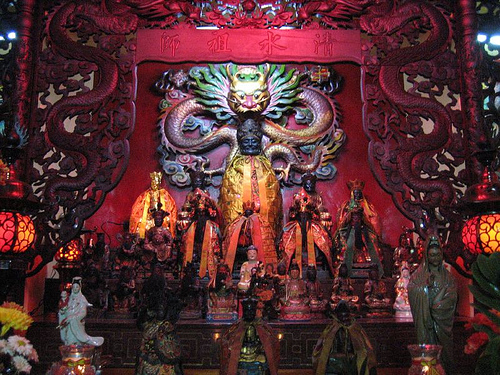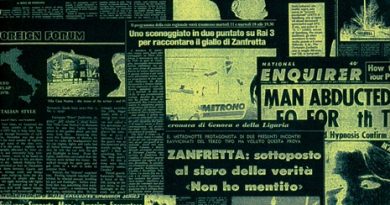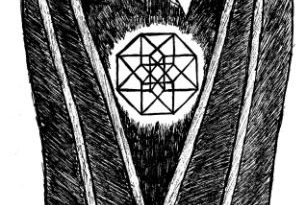The Mysterious Gurus & Cults
Cults seem an enigma. We all know of their existence, or have heard of their more extreme measures such as mass suicide or even violence. Yet most cults are quite innocuous. But still the mystery remains.
How do we draw back the curtains of non-understanding? Well without doubt the most important factor in a cult is the guru himself. And it is to him we must turn to really understand what is going on. Some examples.
MARK PROPHET
In 1958, Mark Prophet was announced as a Messenger of the Masters by Ascended Master, El Morya. Just whether this character actually existed is unknown, but soon Mark began lecturing around America that God exists. In us all is the female presence, and we must all raise our feminine principle to wed the soul to the universal Christ consciousness.
Soon, Mark married Elizabeth and they formed the Summit Lighthouse. In 1973 Mark died but was said to continue to appear to Elizabeth to dictate his wishes. This led to the Church universal and Triumphant in 1974.
The Church was headquartered in a ranch near Livingstone, Montana, which housed a commune. Elisabeth married again, to Ed Francis, who was charged with holding illegal weapons at the ranch. The Church is convinced Armageddon will come through nuclear war. To this end, by 1990 they had sold thousands of places in their shelters for $6,000 a time.
DIVINE LIGHT MISSION
The Divine Light Mission began in 1930 under Sri Hans Maharaj Ji in India. He died in 1966, the religion only operating in India. His eight year old son, Prem Pal Singh Rawat, took over, directed to do so by a divine voice.
Taking the title, Maharaj Ji, he converted some Americans touring India, who invited him to America. News of the boy wonder spread, and thousands turned out to meet him when he arrived in 1971.
In 1973, he held the Millennium 73 event in Houston to declare a thousand years of peace, but it was a flop. Meanwhile, his family ousted him as leader so he returned to India to sue them. He remained in control of his Mission everywhere except in India, and successfully converted followers in South America, Southeast Asia and other regions.
GRIGORI RASPUTIN
A typical cultish guru was the mad monk, Grigori Rasputin. Born a peasant in Siberia in 1872, he became an alcoholic womaniser – traits that never left him. However, after the death of his son he had a vision of the Virgin Mary and went on a pilgrimage to Mt Ethos, Greece.
This turned him into a charismatic healer. Eventually arriving in St Petersburg, he gained favour with the Czarina Alexandra when he seemed to help her son, Alexiss, Haemophilia.
Gaining political hold over the Czar Nicholas, a virtual cult formed in the Russian hierarchy, with Rasputin declaring the End Times for Russia if his ideas were not followed. However, by Decemnber 1916, plots were afoot to kill him. He was invited to a small party where he was poisoned, twice shot, and finally thrown into a river by Prince Feliks Yusupov.
His End Times prediction then came true, with the Russian Revolution the following year and execution of the Royal Family the year after that.
JOSEPH SMITH
Elements of the guru can be found in founders of some movements growing into major religions. A typical case was Joseph Smith, the son of poor Vermont farmers, born in 1805, and founder of the Church of Jesus Christ of Latter-Day Saints, better known as the Mormons.
Caught up in the spiritual revivals of the 1820s, Smith agonised over his faith, leading to a vision of a pillar of light telling him to begin a new Church. Many visions followed, culminating in the appearance to him of an angel in September 1823, telling Smith that he was the descendant of Israel, and his people had lived in America.
Smith was sent on a quest to dig up a number of plates made of gold. He claimed to do this four years later. Translating the hieroglyphics on them, the result was the Book of Mormon.
By 1830 his Church was set up, but persecutions led them to move. In 1844 Smith stood for President, but following a conspiracy, he was charged with treason. Whilst in prison a mob attacked and killed him.
Brigham Young became the new Mormon leader and took them into the wilderness, settling on Salt Lake, Utah, in 1848, and advocating the policy of polygamy, for which the Mormons are famous.
LIFE PATH OF THE GURU
Rasputin and Smith seem to be very different gurus. However, whilst this may be true in a cultural sense, how close was their psychology? Psychiatrist Dr Anthony Storr studies many gurus in his book Feet of Clay: A Study of Gurus, and he built up a picture of the archetypal cult leader.
In early life they tend to have lonely, isolated childhoods. This leads to introversion and narcissistic tendencies. As they grow older, they find friendship difficult to handle. They tend to have acquaintances rather than friends.
This lifestyle eventually leads to a psychological crisis point, leading to acute mental instability. The way out of such a crisis comes with a spiritual realisation; a unique and particular way of understanding the world. And once this realisation is complete, a guru is born.
Building absolute faith from such a realisation, confidence and missionary zeal propel the guru on, formulating the embryo cult through contact, not with friends, but acquaintances.
NARCISSISM
Most gurus go through these stages of life, argues Storr. For many, the eventual cults are essentially good. Jesus himself shows echoes of this process, his mission beginning following the resolution of his psychological traumas in the wilderness. To the people of his time, his view of the world was different, and his initial cult had only twelve members.
The essential goodness of this new cult went on to birth Christianity, where it ceased to be a cult, and eventually became a system lived by a large proportion of humanity.
The problem with such cult formulation lies in the guru who retains his essential narcissism. It is a natural element of growing up for a child to seek love and attention, both of which are narcissistic demands.
Yet for those who do not find fulfillment in life, such impulses do not go away. Thus, writes Storr: Those who remain narcissistic in adult life retain this need to be loved and to be the centre of attention together with the grandiosity which accompanies it.
Thus we have the essential characteristic of a guru who goes off the rails. And as his cult formulates, this weakness in the guru feeds off the adoration of his disciples, whilst the essential religion-seeking of the disciple compels him to follow the guru. The end result can be a cultish system that is unhealthy, childish and destructive.
THE SPIRITUAL EXPERIENCE
The mechanics of the spiritual realisation can be equally important. Brought up a loner without friends, frustrations can come to the fore which lead, in effect, to a psychological illness which masquerades as a spiritual event.
This can cause an over-reliance on a specific spiritual philosophy, such as the Bible. Such an experience is essentially a delusion, but causes the future guru to build his own spiritual philosophy with himself as the centrepiece.
This truth turns the inadequate loner into a charismatic, who gains total control over all those who come under his influence. Such processes can be seen in Rasputin and Smith, and can be found in virtually all cult and founding religious leaders. And a similar process laid behind Mary Baker Eddy.
MARY BAKER EDDY
Born in New Hampshire in 1821, Mary Baker Eddy became founder of the Church of Christ, Scientist. With many physical and mental disabilities in early life, she turned to the Bible, becoming a healer and preacher, and going on to establish her own Church in 1875. Her sect became official in Boston four years later.
We can see, with Mary, a specific theology emerging based on her own experiences of illness, with illness only being combated by prayer, shunning orthodox medicine. To her, physical suffering was an illusion to be conquered by the spirit-filled mind – the main tenets of her Church continued this belief.
As to her general mental health, Mary eventually fell out with her own ministry, and when her third husband, Asa, died, she blamed her detractors who, she argued, had killed him by psychic warfare. Further, there is evidence that she, herself, was affected by another guru, a mental healer called Quimby, from whom she is said to have taken her own philosophy.
EXTREMELY NORMAL
It is easy to see the psychology of such gurus as different from normal behaviour. But to Storr, we can learn much about cults and their relation to normal life by going a little deeper. He argues that the process through which the future guru approaches mental illness and is saved by spiritual enlightenment is similar to normal thought processes in both the arts and science. Both involve a degree of fanaticism where the artist thinks of an idea or the scientist attempts to grasp a theory.
This can often lead to a degree of delusion. When the idea finally comes, it is most likely to come as an inspired thought following relaxation, from the deep unconscious. But the problem with the guru is that the inspiration can, due to mental instability, appear to come from some spiritual being.
Further, whereas the scientist will be kept from delusion by the critical responses of his peers, the guru has no peers to keep his inspiration in perspective. Thus, his delusion is enhanced – fed, even – by his disciples.
Such similarities between delusions and normal thought processes have led Storr to conclude: the dividing line between sanity and mental illness has been drawn in the wrong place; the sane are madder than we think, the mad saner.
Such a view reminds us of Sigmund Freuds assertion that society itself ls not as sane as we would like to think. He asked: May we not be justified in reaching the diagnosis that, under the influence of cultural urges, some civilisations or some epochs of civilisation – possibly the whole of mankind – have become neurotic.
Psychotherapist R D Laing had similar intuitions when he said that our collusive madness is what we call sanity.
IN CONCLUSION
Looking at modern life and its failure to cater for our religious instinct suggests that, in the modern world, the above may be true. If life is not self-fulfilling, it is natural that psychological imbalance in some form will naturally occur.
Hence, it could be argued that it is modern life itself that is responsible for throwing people into cult lifestyles. And, according to Storr, it is the gurus themselves who suffer this lacking the most.
The similarities between a cult and society thus become increasingly obvious. A cult is not some aberration, but simply a more extreme variation of normal social behaviour. An urge towards, say, Armageddon is not some paranoid influence, but simply an extension of frustrations and idiosyncracies within us all.



